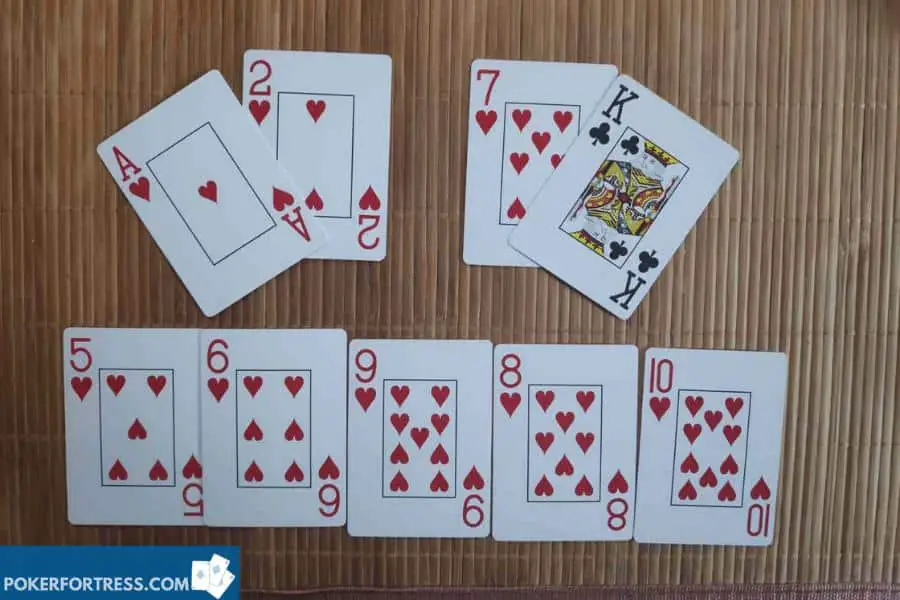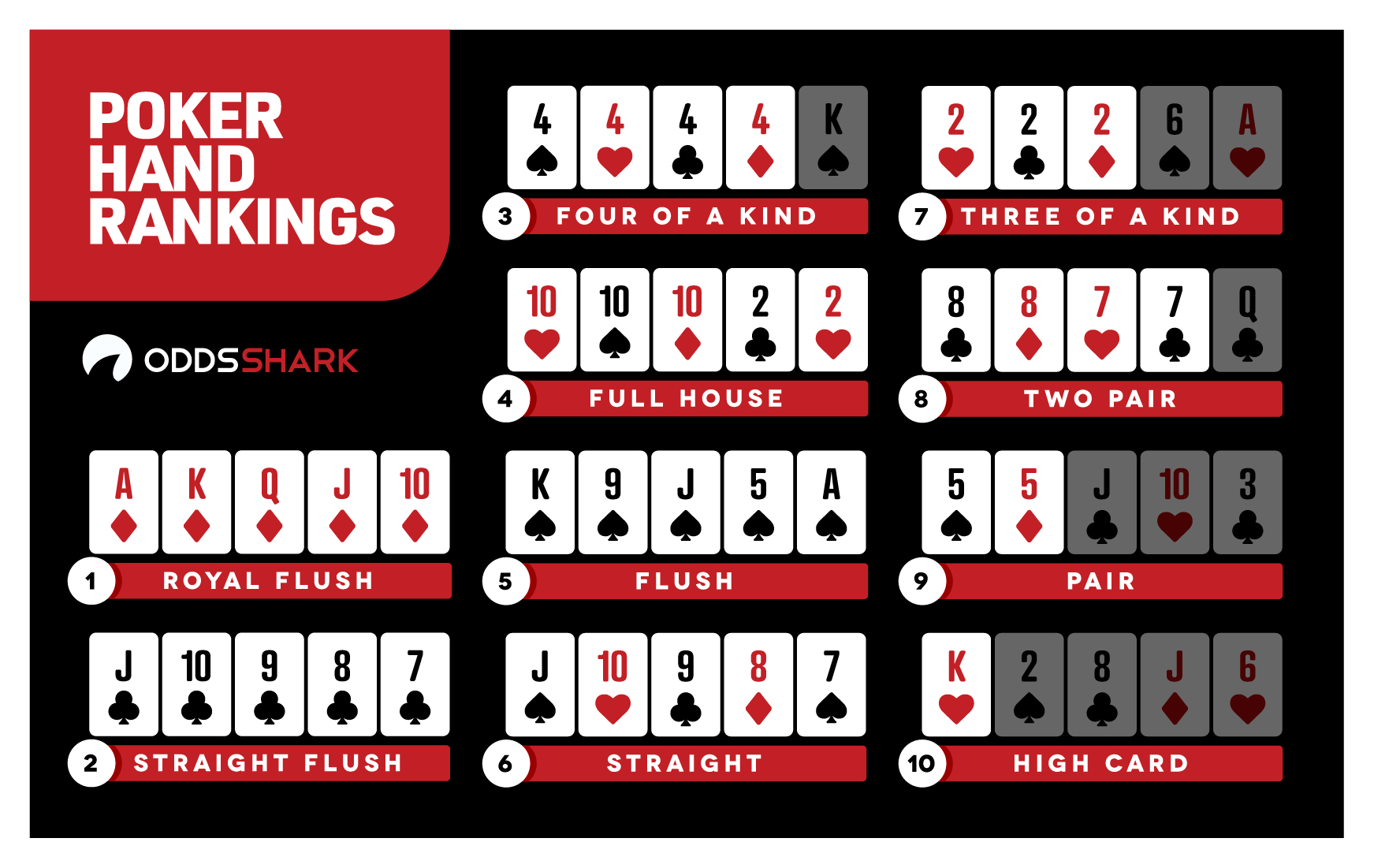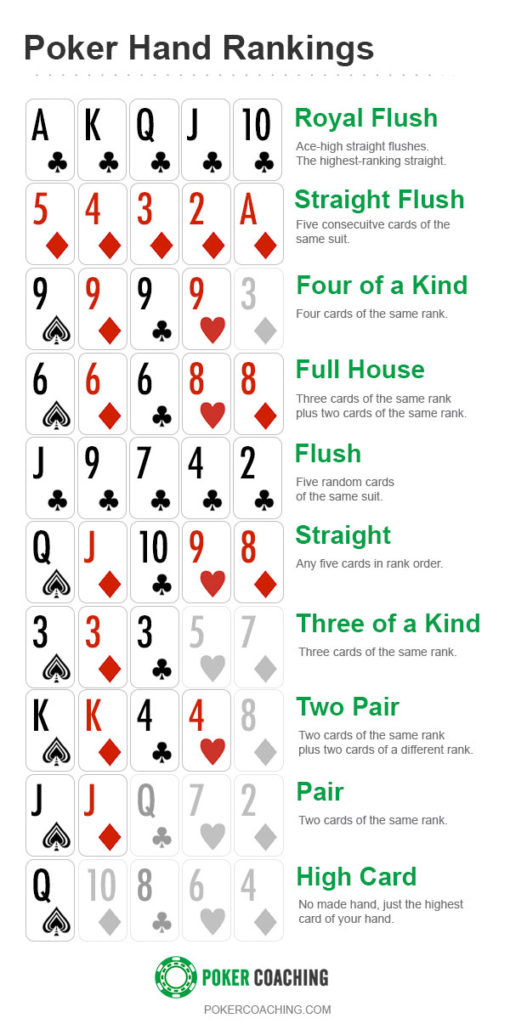Poker Both Have Straight Who Wins
Who wins when two players have a flush? For example, say the first player also has two pair, one in their hand (two 3's), and one on the board (two 8's). The second player has AQ. An ace-high straight flush, commonly known as a royal flush, is the best possible hand in many variants of poker. In poker, players form sets of five playing cards, called hands, according to the rules of the game. Each hand has a rank, which is compared against the ranks of other hands participating in the showdown to decide who wins the pot.
If both players have two pairs, the hand with the highest pair has the winning poker hand and the smaller pair is irrelevant. For example, Q-Q-5-5-3 beats 10-10-7-7-A because the queens beat the tens. If the higher pairs are the same then the smaller pair is used to determine the. A player with the highest rank of straight wins. If both players have the straight of the same rank, then the pot is split. This holds true, of course, if none of them has a higher.
Poker dice are dice which, instead of having number pips, have representations of playing cards upon them. Poker dice have six sides, one each of an Ace, King, Queen, Jack, 10, and 9, and are used to form a poker hand.
Each variety of poker dice varies slightly in regard to suits, though the ace of spades is almost universally represented. 9♣ and 10♦ are frequently found, while face cards are traditionally represented not by suit, but instead by color: red for kings, green for queens and blue for jacks. Manufacturers have not standardized the colors of the face sides. The game can also be played with ordinary dice.
As a game[edit]
The classic poker dice game is played with 5 dice and two or more players. Each player has a total of 3 rolls and the ability to hold dice in between rolls. After the three rolls, the best hand wins.
In most variations, a straight only counts as a Bust (high-card). A Straight is less probable than a Full House, so, if counted, it should rank above a Full House, though tradition usually ranks it below Full House, as in card poker. Neither a 'flush' nor a 'straight flush' is a possible hand, due to the lack of suits on the dice.[1][2]
In some rules, only a straight to a King is called a Straight, while a straight to an Ace is called (somewhat incorrectly) a Flush. Each one has an exact probability of 120 / 7776. Under these rules, a Straight beats a Full House (unlike in card poker, but correctly reflecting its probability) but does not beat a Four of a Kind (incorrectly reflecting its lower probability). A Flush beats a Four of a Kind (as in card poker, and correctly reflecting its lower probability).
Probabilities[edit]
The poker dice hand rankings and the corresponding probabilities of rolling that hand are as follows[3][4](not sorted by probability but from highest to lowest ranking):
| Hand | Exact probability | Percentage | 1 in ... | Example |
|---|---|---|---|---|
| Five of a kind | 6 / 7776 | 0.08% | 1296 | J J J J J |
| Four of a kind | 150 / 7776 | 1.93% | 51.8 | 10 10 10 10 A |
| Full house | 300 / 7776 | 3.86% | 25.9 | K K K 9 9 |
| Straight | 240 / 7776 | 3.09% | 32.4 | A K Q J 10 |
| Three of a kind | 1200 / 7776 | 15.43% | 6.5 | 9 9 9 K J |
| Two pair | 1800 / 7776 | 23.15% | 4.3 | Q Q 9 9 A |
| One pair | 3600 / 7776 | 46.30% | 2.2 | 10 10 K Q 9 |
| Bust (high card; no pair, no straight) | 480 / 7776* | 6.17% | 16.2 | A K Q J 9 |
Poker Both Have Straight Who Wins
*Busts have much lower probability than in card poker, because there are only 6 values instead of 13, making pairs and straights much more likely than with cards. In poker dice there are in fact only four possible bust hands: [A K Q J 9], [A K Q 10 9], [A K J 10 9], and [A Q J 10 9]; both other no-pair hands (i.e., in which either the A or the 9 are missing) are straights. Consequently, in some variants of the rules, straights are counted as busts.[5]
Variants[edit]
Marlboro once marketed a set of octahedral poker dice that included suits; each die had slightly different numberings, ranging from 7 up to ace. A similar set is currently manufactured by Koplow Games.[6][7]
In 1974, Aurora produced a set of 12-sided poker dice called 'Jimmy the Greek Odds Maker Poker Dice'[8] and in 2000, Aurora/Rex Games produced a similar set under the name 'Royal Poker Dice'.[9] The sets featured five 12-sided dice allowing for all 52 playing cards to be represented. The remaining 8 faces featured stars and acted as wild cards allowing for every possible poker hand to be rolled.
See also[edit]
Poker Both Have Straight Who Wins World Series
References[edit]
- ^Berger, A. J.; Bruning, Nancy (1979). Lady Luck's Companion: How to Play ... how to Enjoy ... how to Bet ... how to Win (illustrated ed.). Harper & Row. p. 57. ISBN978-0-06-014696-2.
- ^Bewersdorff, Jörg (2004). Luck, Logic, and White Lies: The Mathematics of Games. CRC Press. p. 22. ISBN978-1-000-06531-2.Extract of page 22
- ^Deep, Ronald (2006), Probability and statistics with integrated software routines, Elsevier Inc., ISBN0-12-369463-9Chapter 1 p 42
- ^Bărboianu, Cătălin (2006), Probability Guide to Gambling: The Mathematics of Dice, Slots, Roulette, Baccarat, Blackjack, Poker, Lottery and Sport Bets, INFAROM Publishing, p. 224, ISBN973-87520-3-5Extract of page 224
- ^Arneson, Erik (2012). 'The Complete Rules for the Dice Game Poker Dice'. About.com. New York Times Company. 'Board / Card Games' subsite. Archived from the original on 2014-04-12.CS1 maint: unfit URL (link)
- ^Koplow Games
- ^8-sided poker dice on BoardGameGeek.com
- ^Jimmy the Greek Odds Maker Poker Dice on BoardGameGeek.com
- ^Royal Poker Dice on BoardGameGeek.com
External links[edit]
- Rules for Dice Poker at BrainKing.com (similar to Yahtzee)
- Arneson, Erik (2012). 'The Complete Rules for the Dice Game Poker Dice'. About.com. New York Times Company. 'Board / Card Games' subsite. Archived from the original on 2014-04-12.CS1 maint: unfit URL (link) (no straights)
- Poker dice at Britannica.com
When two players appear to have the same hand in poker, deciding who is the winner is not always easy. I’ve played for over 10 years and will show you how to determine whether there is a winner or if there it is a tie.
What happens if you have the same hand in poker? If two or more players have the same hand the high card determines the winner. For straights or flushes, the highest top card is declared the winner. For one pair and two pair hands, the highest kicker wins. If players have the same 5-card hand, it is a tie and the pot is split equally.

Sometimes the basics are not enough and further explanation is needed. Let’s go through all the possible hands and show how a tiebreaker is handled for each and every possible situation in poker.
Poker Tiebreaker Rules
Having a tie in poker is actually a fairly rare thing. For the purposes of this article we will focus on ties in Texas Hold’em. However, the methodology works for any form of poker.
Who Wins If No One Has a Pair? High Card Tiebreaker Rules
The easy way to determine who wins if no one has even a pair is for everyone to put their hands in order from high to low. Then, simply start at the top and work your way down until the tie is broken. The highest non-tie card wins.
High-Card Tiebreaker Examples:

- AJT85 beats AJT82
- T8542 Beats T7653
- 85432 Beats 76542
- K6542 Beats K6532
What Happens If Two Players Have the Same One-pair Hand?
If two or more players have the same pair, you use the same methodology as you do for high-card hands. The next highest non-tie card determines the winner.
One-Pair Tiebreaker Examples:
- KKT75 beats KK942
- 88652 Beats 88642
- AAK83 Beats AAK82
Who Wins in Poker If Both Players Have 2 Pair? Two-Pair Tiebreaker Rules
Two pair winners are really easy to determine, the player with the higher pair wins. For example, JJ22 beats TT99.
If both players have the same two pair, it is also easy to figure out the winner since there is only one kicker. Whichever kicker is higher wins.
Two-Pair Tiebreaker Examples:
Poker Both Have Straight Who Wins Against
- 7733A beats 55442
- JJTT8 beats JJTT5
- 8822A beats 8822K
Three of a Kind Tiebreaker Rules
The person with the highest three of a kind wins. If two players have the same three of a kind, then the kickers are used to determine the tiebreaker.
Three of a Kind Tiebreaker Examples:Which Hand Is Best in High-Low Poker?
- TTT92 beats 77743
- QQQT2 beats QQQ76
Poker Both Have Straight Who Wins Losses
What Happens If Two Players Have a Straight or Flush?
If two or more players have a straight or flush, whoever has the top card wins.
Straight & Flush Tiebreaker Examples:
- 76543 beats 5432A (Ace is a one in this case)
- J♠ 9♠ 5♠ 3♠ 2♠ beats T♠ 8♠ 7♠ 6♠ 4♠
What If Two Players Have a Full House?
To break a tie with a full house, whoever has the highest “trips” parts of their hand wins. The “pair” part of the hand does not matter except as a tiebreaker. If the pairs are the same as well, then the hand is a tie and the pot is split.
Full House Tiebreaker Examples:
- TTT22 beats 777AA
- 555JJ beats 444KK
- QQQ33 beats QQQ22
Four of a Kind, Straight Flushes, and Royal Flushes
Unless the hand is on the board, it is extremely rare for there to be two players with the same ultra-premium hand like four of a kind, a straight flush, or a royal flush. However, it is easy to decide who is the winner.
- Four of a kind – The highest four of a kind hand wins
- Straight flush– Usually when this happens, one player will have the top of the straight flush and the other the bottom. The top wins.
- Royal flush– The only time it is possible for two players to have a royal flush is if it is on the board. Even if it was possible, two royal flushes is always a tie. Contrary to what some people believe, one suit does not beat another suit unless a specific local rule dictates it.
What Happens If Players Have the Same Hand Even After a Tiebreaker?
Can there be a tie in poker? In poker, if no winner can be determined with a tiebreaker, then the hand is declared a tie and the tied players split the pot. The most frequent time there is a tie in poker is where the board is paired twice and two or more players each have the same high card.
Examples of tied hands:
- One player has AK and the other has AQ and the board is J2255. Each player has A2255 and for a tie.
- One player has A8 and another has A6. The final board is AQJJ9. Both players have a pair of Aces with kickers of QJJ9. They would split the pot.
- One player has 98 and the other has 92. The final board is AKQT5. Both players have the high card hand AKQT9. The pot is once again split between them.
What If the Best Hand Is on the Board?
If no part of anyone’s hand can break the tie, then the pot is split equally among the players with
How Do We Split up the Pot?
The easiest method to split up a pot in poker is to start with the highest chip color and work your way down. If there is an uneven number of a color, you pull in enough from the next lowest amount to even it up. Then start the process again with the next highest color available.
What If There Is an Uneven Amount in the Pot?
If there is an extra chip left over after the pot has been split, then the first player seated clockwise from the dealer gets it. In heads-up, the player who was the Big Blind gets the extra chip.
Which Hand Is Best in High-Lo Poker?
There are a few variations of poker, namely Omaha Hi-Lo where the low hand wins half of the pot. In this case, whoever can make the lowest possible hand that isn’t a straight
In order to qualify for a low hand, the highest card has to be 8 or lower. 86532 qualifies but 95432 does not.
What Are Common Tie-Breaker Mistakes?
In pub poker or home games, I see people scoop a pot quite frequently when it was supposed to be a tie. The most common time this happens is when someone is dominated and then their kicker is counterfeited at some point during the hand.
Here are some examples:
Poker Same Straight Who Wins
AQ vs. A2– Board runs out A588K, which means they both are holding two pair Aces and eights with a King kicker. I have witnessed the pot be pushed to the AQ guy and the next hand be about to start before anyone notices.

66 vs. 44– Board runs out KTT7K, which means they both are playing the board with two-pair, Kings over Tens with a
In Poker If Both Players Have A Straight Who Wins
AA vs. AK– Board runs out 97568, with a straight on the board it’s a split pot. Yet you’d be surprised how often the guy with AA will try to drag in the entire pot.
Remind Me, What Is the Hand Ranking Order Again?
Poker Both Have Straight Who Wins Ncaa Basketball
Ranked from best hand to worst:
- Royal Flush
- Straight Flush
- Four of a Kind
- Full House
- Flush
- Straight
- Three of a Kind
- Two-Pair
- One-Pair
- High Card
Final Thoughts
Now you know how to break any possible tie in poker if two players seem to have the same hand. If you want to learn the basics of poker strategy, you might want to check out my complete poker tutorial. Thanks for reading!

Related Questions
Can you have two hands in poker? You are required to always play your highest hand possible in Texas hold’em or other poker games. However, if you verbally announce a weaker version of your hand then you actually have, the dealer may actually force you to play the weaker hand.
Which is higher straight or flush? According to the hand ranking rules of poker, a flush always beats a straight.
Is JQKA2 a straight? AThis is know as an around-the-corner straight and is only used as a special rule in some home games. In games that follow the exact rules of poker, JQKA2 is not considered a straight and is just an Ace-high high-card hand.